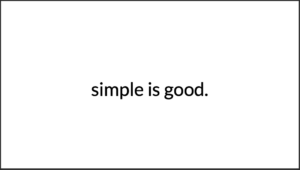Simple is Good
“Simple is good.”
When I think of this phrase, it takes me back to a time early in my career. I had moved into the information technology department of a fast-growing company, and I was responsible for software configuration. It was a robust warehouse management system that was new technology to the world and to our company.
As we began to learn its capabilities and to implement its usage, people in our distribution center and operations group began to imagine all sorts of solutions. They began to ask (and sometimes demand) that I configure the software to make their lives easier or to fulfill some sort of need.
At some point, I began to get overwhelmed at how many requests I was getting. And I began to notice that often the requests were competing against each other. On top of that, the requests were coming in quicker than our small IT team could accomplish them.
A Sign to Guide Me
That’s when I had the idea of making a sign. I needed something to guide me. Eventually, it became a guiding design principle (and leadership principle) that I shared with everyone who came to me with a request.
I opened up PowerPoint, and on a blank white slide, I typed these words,

“simple is good.”
I didn’t even capitalize the first letter. All lower case. Simple.
No colors – just black and white. No borders. Just a simple phrase.
From that day on, when people came to me requesting some complex idea for a technology solution, I would listen, and then I would point at the sign, “Simple is good.”
I would ask them, “How can we make it simple?”
“How can we eliminate complexity from this situation or solution?”
After that, we had a different kind of conversation focused on well-designed solutions that centered on a key problem or need.
Fast forward 28 years later to my work today. I work with clients crafting vision statements, strategic plans, business plans and people development strategies for leadership teams. I find myself returning to this simple phrase on a regular basis.
“Simple is good.”
Strive for Simplicity
Whatever problem you are designing or solving for today, remember that complexity will come on its own. New solutions have a tendency to be built on layers of complexity. Instead, strive for simplicity. Lead others to create simple solutions. Simple solutions are efficient and easier to implement, teach and maintain.
The next time you are tasked with designing a new solution, take the extra time to make it simple.
Because simple is good.
